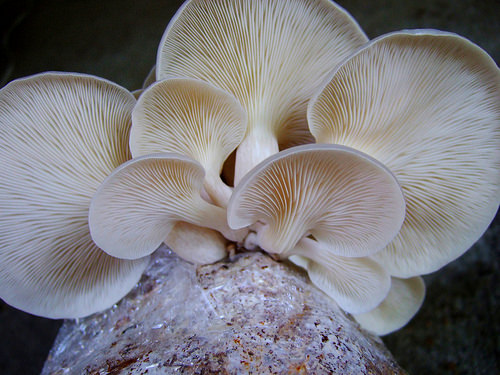Rice straw is abundant in most Asian countries where rice is a major crop, and can be purchased for a reasonable price. Rice straw can be used as the basic material for mushroom cultivation. Mushrooms are capable of breaking down organic material that other microorganisms cannot decompose. The common field mushroom and many other types of mushroom (Agaricus spp.) grow well on compost made from rice straw.

Effectiveness of the Technology
Mushroom production can generate a good income for farmers, and utilize surplus manpower in rural areas. The organic matter left over after mushrooms have been cropped on rice straw can be recycled onto cropland as organic fertilizer.
Explanation of the Technology
Rice straw can be used as the main substrate for mushroom cultivation. First, it should be composted. To improve the nutrient content, materials such as chicken manure, rice bran, urea, and gypsum may be mixed with the straw. For each ton of dry rice straw, growers can add 100 kg of chicken manure, 50 kg of rice bran, 12 – 15 kg of urea, and 10 kg of gypsum. The rice straw is prepared by composting.
Outdoor Composting
Pre-Wetting
Dry rice straw is cut to a length of 10 – 20 cm, and soaked with water (for 2 – 3 days in spring, six months after the straw has been cut, and 1-2 days in autumn, immediately after the rice harvest).
Stacking and Turning
The compost must be stacked and left to mature for 15 – 20 days in autumn, and 20 -25 days in spring. During this time, the compost must be kept moist and turned repeatedly.
The purpose of turning the compost is to make sure that the materials are thoroughly mixed, and that there is an even moisture content throughout the stack. Turning also helps regulate the temperature. When the temperature in the center of the stack rises to more than 70oC, the compost should be turned.
Indoor Mushroom Beds
Usually, the culture bed is filled with about 110 kg of compost per square meter.
Pasteurization and Conditioning
Once the compost has been put in the bed for mushroom production, it should be pasteurized by allowing the heat to rise to 58 – 60oC for 4 – 6 hours. Afterwards, the temperature should be kept at 48 – 55oC for 6 – 8 days, to allow the compost to mature.
Spawning of the Mushrooms
When you are ready to sow the mushroom spawn, the temperature of the compost should be reduced as quickly as possible, from 48 – 50oC to less than 25oC. The spawn needs to be spread in several layers. Thirty percent of the spawn should be spread on the bottom third of the compost, 30% of the spawn on the middle third of the compost, and 30% of the spawn on the top third of the compost. The final 10% of the spawn should be spread over the surface of the remaining compost. From an economic point of view, the optimum quantity of spawn is 2-3 kg (6 – 8 pounds) of spawn per 300 kg of compost.
After spawning, the temperature of the compost must be kept at 25 – 28oC. The humidity of the air should be around 90 – 95%. The bed will be completely filled with mycelium after 10 – 15 days.
Soil Preparation and Casing
A casing material to enclose the mushroom bed is prepared by mixing clay loam and peat at a rate of 8:2 (v/v). The optimal pH of the casing soil is 7.0 – 7.5.
To kill harmful mold and other microorganisms, casing soil should be sterilized by steaming it for 5 – 6 hours at 60 – 65oC, or 1 hour at 80oC.
The casing for the compost and spawn should be around 2.5 – 3.0 cm thick. After casing, the optimal temperature for mycelial growth is 25 – 28oC.
Caring for and Harvesting the Crop
It is very important to provide proper ventilation and water, and to maintain suitable levels of temperature and humidity for the mushrooms. At harvest, the air temperature should be maintained at 15 – 16oC.
Note: After all the mushrooms are picked, the mushroom-growing chamber and its contents should be sterilized with steam and then emptied, to prevent any pathogen from contaminating the next crop.
Cooperating agency for this topic:
National Institute of Agricultural Science and Technology (NIAST)
Rural Development Administration (RDA)
Suwon, Republic of Korea, 2002-03-01
Source: agnet.org
